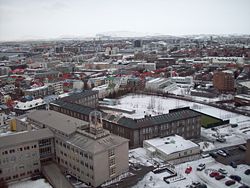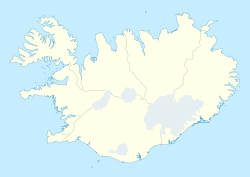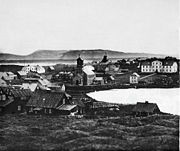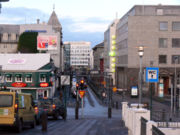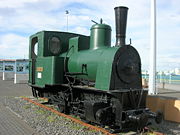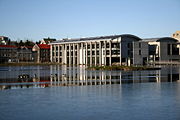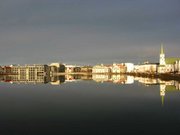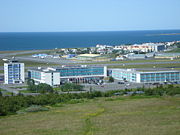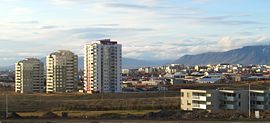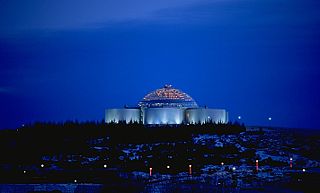Reykjavík
2008/9 Schools Wikipedia Selection. Related subjects: Europe; European Cities
| City of Reykjavík Reykjavíkurborg |
|
| Reykjavik seen from Hallgrímskirkja | |
| Location in Iceland | |
| Coordinates: | |
|---|---|
| Constituency | Reykjavík North Reykjavík South |
| Government | |
| - Mayor (Borgarstjóri) | Ólafur F. Magnússon |
| Area | |
| - City | 274.5 km² (106 sq mi) |
| - Metro | 777 km² (300 sq mi) |
| Population ( April 1, 2008) | |
| - City | 118,861 |
| - Density | 428/km² (1,108.5/sq mi) |
| - Metro | 198,782 |
| - Metro Density | 187.4/km² (485.4/sq mi) |
| Postal Codes: 101-155 | |
| Website: http://www.rvk.is/ | |
Reykjavík (IPA: [ˈreiːcʰaˌviːk]) is the capital and largest city of Iceland. Its latitude at 64°08' N makes it the world's most northern national capital. It is located in southwestern Iceland, on the southern shore of Faxaflói Bay. With a population of 119,000, it is the heart of Iceland's economic and governmental activity.
Reykjavík is believed to be the location of the first permanent settlement in Iceland, which Ingólfur Arnarson is said to have established around 870. Until the 18th century, there was no urban development in the city location. The city was founded in 1786 as an official trading town and grew steadily over the next decades, as it transformed into a regional and later national centre of commerce, population and governmental activities.
Today, Reykjavík is the centre of the Greater Reykjavík Area which, with a population of 200,000, is the only metropolitan area in Iceland. As a highly modernized capital of one of the most developed countries in the world, its inhabitants enjoy a first-class welfare system and city infrastructure. Its location, only slightly south of the Arctic Circle, receives only four hours of daylight on the shortest day in the depth of winter; during the summer the nights are almost as bright as the days. It has continued to see population growth in past years as well as growth in areas of commerce and industry.
Reykjavík was recently ranked first on Grist Magazine's "15 Greenest Cities" list.
Geography
Reykjavík is located in southwest Iceland. The Reykjavík area coastline is characterized by peninsulas, coves, straits, and islands.
During the Ice Age (up to 10,000 years ago) a large glacier covered parts of the city area, reaching as far out as Álftanes. Other parts of the city area were covered by sea water. In the warm periods and at the end of the Ice Age, some hills like Öskjuhlíð were islands. The former sea level is indicated by sediments (with clams) reaching (at Öskjuhlíð, for example) as far as 43 m above the current sea level. The hills of Öskjuhlíð and Skólavörðuholt appear to be the remains of former shield volcanoes which were active during the warm periods of the Ice Age.
After the Ice Age, the land rose as the heavy load of the glaciers fell away, and began to look as it does today.
But the capital city area continued to be shaped by earthquakes and volcanic eruptions, like the one 4500 years ago in the mountain range Bláfjöll, when the lava coming down the Elliðaá valley reached the sea at the bay of Elliðavogur.
The largest river to run through Reykjavík is the Elliðaá River, which is non-navigable. It is one of the best salmon fishing rivers in the country. Mt. Esja, at 914 m, is the highest mountain in the vicinity of Reykjavík.
The city of Reykjavík is mostly located on the Seltjarnarnes peninsula, but the suburbs reach far out to the south and east. Reykjavík is a spread-out city; most of its urban area is in the form of low-density suburbs, and houses are usually widely spaced. The outer residential neighbourhoods are also widely spaced from each other; in between them run the main traffic arteries and a lot of empty space.
Climate
Despite its extreme north Atlantic location, Reykjavík is much warmer than most locations at a similar latitude. The average mid-winter temperatures are no lower than those in New York City, with average temperature in January of 0°C, but temperatures very rarely drop below -10°C (14°F) in the winter. This is because the Icelandic coastal weather in winter is moderated by the warm waters of the Gulf Stream. The climate is subpolar oceanic, and the city is on the northern edge of the temperate zone. The city's coastal location does make it prone to wind, however, and gales are common in winter. Summers are cool, with temperature fluctuating between 10 - 15°C, sometimes exceeding 20°C (68°F). Reykjavík is not a particularly wet city, but it nevertheless averages 213 days with measurable precipitation every year. Spring tends to be the sunniest season. Annual sunshine hours in Reykjavik are around 1300, which is comparable with other places in Northern and North-Eastern Europe. The highest ever recorded temperature in Reykjavik was 26.2°C (79°F), recorded on 30 July 2008, while the lowest ever recorded temperature was -24.5°C (-12°F), recorded on 21 January 1918
Places in the world with similar climate: Thorshavn, Faroe Islands; Dutch Harbour, Alaska; Ushuaia, Argentina; Stanley, Falkland Islands.
| Month | Jan | Feb | Mar | Apr | May | Jun | Jul | Aug | Sep | Oct | Nov | Dec | Year |
|---|---|---|---|---|---|---|---|---|---|---|---|---|---|
| Average high | 2°C (36°F) | 2.5°C (37°F) | 4°C (39°F) | 6°C (43°F) | 10°C (50°F) | 12°C (54°F) | 14°C (57°F) | 14°C (57°F) | 11°C (52°F) | 7°C (45°F) | 4°C (45°F) | 2°C (36°F) | 7.4°C (45°F) |
| Average low | -2°C (28°F) | -2°C (28°F) | -1°C (30°F) | 1°C (34°F) | 4°C (39°F) | 7°C (45°F) | 10°C (50°F) | 8°C (46°F) | 6°C (43°F) | 3°C (37°F) | 0°C (32°F) | -1°C (30°F) | 2.7°C (36.9°F) |
| Total rainfall | 89mm (3.5") | 64mm (2.5") | 62mm (2.4") | 56mm (2.2") | 42mm (1.7") | 42mm (1.7") | 50mm (2.0") | 56mm (2.2") | 67mm (2.6") | 94mm (3.7") | 78mm (3.1") | 79mm (3.1") | 779mm (30.7") |
Cityscape
History
The first permanent settlement in Iceland by Nordic people is believed to have been established in Reykjavík by Ingólfur Arnarson around AD 870; this is described in Landnámabók, or the Book of Settlement. Ingólfur Arnarson is said to have decided the location of his settlement using a traditional Viking method; by dumping his high seat pillars, Öndvegissúlur, in the ocean when he saw the coastline and then settled where the pillars came to shore. Steam from hot springs in the region is supposed to have inspired Reykjavík's name, as Reykjavík translates to "Smokey Bay".
Reykjavík is not mentioned in any medieval sources except as a regular farm land but the 18th century saw the beginning of urban concentration there. The Danish rulers of Iceland backed the idea of domestic industry in Iceland that would help to stimulate much-needed progress on the island. In 1752, the King of Denmark donated the estate of Reykjavík to the Innréttingar Corporation; the name comes from Danish "indretninger", meaning enterprise. The leader of this movement was Skúli Magnússon. In the 1750s several houses were constructed to house the wool industry that was to be Reykjavík's most important employer for a few decades and the original reason for its existence. Other crafts were also practised by the Innréttingar, such as fisheries, sulphur mining, agriculture, and shipbuilding.
The Danish Crown abolished monopoly trading in 1786 and granted six communities around the country an exclusive trading charter, Reykjavík was one of them and the only one to hold on to the charter permanently. 1786 is regarded as the date of the city's founding; its 200th anniversary was celebrated in 1986. Trading rights were still limited to the subjects of the Danish Crown however, and Danish traders continued to dominate trade in Iceland. Over the following decades, their business in Iceland expanded. After 1880, free trade was expanded to all nationalities and the influence of Icelandic merchants started to grow.
Nationalist sentiment gained influence in the 19th century and ideas of Icelandic independence became widespread. Reykjavík, as Iceland's only city, was the melting pot of such ideas. Advocates of an independent Iceland realized that a strong Reykjavík was fundamental to that objective. All the important years in the history of the independence struggle are important for Reykjavík as well. In 1845, Alþingi, or the general assembly that Icelanders formed in 930, was re-established in Reykjavík; it had been suspended a few decades earlier when it was located at Thingvellir. At the time it only functioned as an advisory assembly with the function of advising the King about Icelandic affairs. The location of Alþingi in Reykjavík effectively established the city as the capital of Iceland. In 1874 Iceland was given a constitution and with it, Alþingi gained some limited legislative powers and in essence became the institution that it is today. The next step was to move most of the executive power to Iceland and that was done by Home Rule in 1904 when the office of minister for Iceland was established in Reykjavík. The biggest step towards an independent Iceland was taken December 1, 1918 when Iceland became a sovereign country under the Crown of Denmark, the Kingdom of Iceland.
| 1801 | 600 |
|---|---|
| 1860 | 1,450 |
| 1901 | 6,321 |
| 1910 | 11,449 |
| 1920 | 17,450 |
| 1930 | 28,052 |
| 1940 | 38,308 |
| 1950 | 55,980 |
| 1960 | 72,407 |
| 1970 | 81,693 |
| 1980 | 83,766 |
| 1985 | 89,868 |
| 1990 | 97,569 |
| 1995 | 104,258 |
| 2000 | 110,852 |
| 2005 | 114,800 |
| 2006 | 115,420 |
| 2007 | 117,721 |
| 2008 | 118,861 |
In the 1920s and 1930s most of the growing Icelandic fishing trawler fleet sailed from Reykjavík and salt-cod production was the main industry but the Great Depression hit Reykjavík hard with unemployment and labour union struggles that sometimes became violent.
In the morning of May 10, 1940, following the German occupation of Denmark on April 9, four warships approached Reykjavík and anchored in the harbour. Many citizens were relieved to find that they were British rather than German. In a few hours, the allied occupation of Reykjavík was complete. There was no armed resistance and taxi and truck drivers even assisted the invasion force which had no motor vehicles initially. The Icelandic government had received many requests from the British government to consent to the occupation, but they always declined on the basis of the Neutrality Policy. For the remaining years of World War II, British and later American soldiers built bases in Reykjavík; the number of foreign soldiers in Reykjavík became about the same as the local population of the city.
The economic effects of the occupation were quite positive for Reykjavík: the unemployment of the depression years vanished and a lot of construction work was done. The British built Reykjavík Airport, which is still in service today, mostly serving domestic flights; the Americans built Keflavík Airport that later became Iceland's primary international airport, situated 50 km from Reykjavík. In 1944 the Republic of Iceland was founded and a president elected in popular elections replaced the King; the office of the president was placed in Reykjavík.
In the post-war years, the growth of Reykjavík accelerated. A mass exodus from the rural countryside began, largely due to improved technology in agriculture that reduced the need for manpower, and because of the population boom resulting from better living conditions in the country. Young people in the prime of their lives were the largest group to move to the capital to live the "Reykjavík Dream", and the city became a city of children. A once primitive village was rapidly transformed into a modern city. Private cars became common and modern apartment complexes rose in the expanding suburbs. Much of Reykjavík lost its village feel. In 1972, Reykjavík hosted the world chess championship between Bobby Fischer and Boris Spassky.
Reykjavík has in the last two decades become a significant player in the global community. The 1986 Reykjavík Summit between Ronald Reagan and Mikhail Gorbachev underlined Reykjavík's new-found international status. Deregulation in the financial sector and the computer revolution of the 1990s have transformed Reykjavík yet again. The financial sector and information technology are now significant employers in the city. The city has fostered some world famous talents in recent years, such as singer Björk, the band Múm and Sigur Rós.
Administration
Reykjavík is governed by the city council, directly elected by those aged over 18 and registered with domicile in the city. The council has 15 members that are elected for 4 year terms. The Independence Party had overall control of the city council from the party's establishment in 1929 until 1978, when they narrowly lost their overall majority. From 1978 to 1982 the People's Alliance, the Social Democratic Party and the Progressive Party formed the majority of the council. The Independence Party regained overall control in the 1982 elections, and held it until 1994. At that election its opponents had formed an alliance, called Reykjavíkurlistinn, or the R-list. That alliance had overall control until 2006. In the May 2006 elections the electorate could choose between five different parties, three of which had formed the R-list. The Independence Party obtained 7 members of the council, and thus failed to gain overall control, but together with the Progressive Party, and its one council member, they were able to form a new majority in the council which took over in June 2006. In October 2007 a new majority was formed on the council, consisting of members of the Progressive Party (1), the Social Democratic Alliance (4), the Left-Greens (2) and the F-list (1) (liberals and independents), after controversy regarding REI, a subsidiary of OR, the city's energy company. However three months later the leader of the F-list formed a new majority together with the Independence Party. Ólafur F. Magnússon, the leader of the F-list, was elected mayor on 24 January 2008, but in March 2009 the Independence Party is due to appoint a new mayor.
The city council governs the city of Reykjavík according to law number 45/1998 . The city council selects members of the boards, and each board controls a different field under the city council's authority. The most important board is the city board that wields the executive rights along with the city mayor. The city mayor is the uppermost public official in the city and also the director of city operations. Other public officials then control different institutions under the mayor's authority.
Thus the administration consists of two different parts:
- the political power that the city council wields and other boards under its authority, and
- the official system where public officials under the authority of the city mayor lok after the administration and management of the policy.
The mayor is appointed by the city council; usually one of the council members is chosen but they may also appoint a mayor who is not a member of the council.
The office of mayor was introduced from 1907, and in 1908 applications for that position were requested. Two applications were received, from Páll Einarsson, sheriff and town mayor of Hafnarfjörður and from Knud Zimsem, town councillor in Reykjavík. Páll was appointed on 7 May and was mayor for six years. At that time the city mayor received a salary of 4500IKR per year and 1500IKR for office expenses.
In 1976 the winter friendship games were hosted in Reykjavík. These are in substitution of the Winter Olympics which were also hosted that year.
Reverse timeline of mayors
- Ólafur F. Magnússon — since 24 January 2008
- Dagur B. Eggertsson — 16 October 2007 – 24 January 2008
- Vilhjálmur Þ. Vilhjálmsson — 13 June 2006 – 16 October 2007
- Steinunn Valdís Óskarsdóttir — 30 November 2004 – 13 June 2006
- Þórólfur Árnason — 1 February 2003 – 30 November 2004
- Ingibjörg Sólrún Gísladóttir — 13 June 1994 – 1 February 2003
- Árni Sigfússon — 17 March 1994 – 13 June 1994
- Markús Örn Antonsson — 16 July 1991 – 17 March 1994
- Davíð Oddsson — 27 May 1982 – 16 July 1991
- Egill Skúli Ingibergsson — 15 August 1978 – 27 May 1982
- Birgir Ísleifur Gunnarsson — 1 December 1972 – 15 August 1978
- Geir Hallgrímsson — 6 October 1960 – 1 December 1972
- Auður Auðuns and Geir Hallgrímsson — 19 November 1959 – 6 October 1960
- Gunnar Thoroddsen — 4 February 1947 – 6 October 1960
- Bjarni Benediktsson — 8 October 1940 – 4 February 1947
- Pétur Halldórsson — 1935 – 1940
- Jón Þorláksson — 1932 – 1935
- Knud Zimsen — 1914 – 1932
- Páll Einarsson — 1908 – 1914
Demographics
The population of Reykjavík in April 2008 was 118,861, the combined population of the Greater Reykjavík Area being about 198,782. Six of the municipalities of Iceland are in the capital city area, those are as listed below:
- Álftanes: 2,416
- Garðabær: 10,139
- Hafnarfjörður: 25,107
- Kópavogur: 29,301
- Mosfellsbær: 8,317
- Seltjarnarnes: 4,453
Economy
Borgartún is the financial centre of Reykjavík, hosting a large number of companies and three investment banks.
Major companies
- Iceland Telecom
- Baugur Group - Investments
- Eimskip - Transport
- Nýherji - Information Technology
- FRISK Software International - Antivirus
- HB Grandi - Fisheries
- Stodir - Investments
- Glitnir - Bank
- Marel - High tech food processing products
- deCODE Genetics -
- Kaupthing Bank
- Landsbanki
- Vodafone Iceland
- Orkuveita Reykjavíkur - Reykjavík Energy
- SPRON - Bank
- Össur hf
- Icelandair Group
- Crowd Control Productions (CCP) - Makers of the EVE Online computer game
Infrastructure
Roads
Per capita car ownership in Iceland is among the highest in the world, though Reykjavík is not severely affected by congestion. Wide multi-lane highways run all over the city connecting the different neighbourhoods and suburbs. Parking spaces are also plentiful in most areas. Public transportation consists only of a bus system (called Strætó bs) and is not very popular in this car-friendly city. Route 1 (the Ring Road) runs by the city outskirts and connects it to the rest of Iceland.
Airports and seaports
Reykjavík Airport, the second largest airport in the country (after Keflavík International Airport), is positioned inside the city, just south of the city centre. It is mainly used for domestic flights as well as flights to Greenland and the Faroe Islands. It was built there by the British occupation force during World War II , when it was on the outskirts of the then much smaller Reykjavík. In recent years there has been some controversy regarding the location of the airport, since it takes up a lot of valuable space in central Reykjavík.
Reykjavík has two seaports, the old harbour near the city centre which is mainly used by fishermen and Cruise ships and Sundahöfn in the east city which is the largest cargo port in the country.
Heating
Abundant water and volcanic activity in Iceland have provided Reykjavík with a unique opportunity. Most houses in Reykjavík use the geothermal heating system. It is the largest system of this kind in the world.
Culture
Nightlife
Reykjavík is often dubbed "the nightlife capital of the north" . It is famous for its nightlife during the weekends. Icelanders tend to go out late so bars that look rather quiet can fill up suddenly - usually around midnight on a weekend.
One of the main causes for this is that alcohol is relatively expensive at bars, so people tend to drink at home before going out. Beer was banned in Iceland until 1 March 1989, but has since become popular among many Icelanders as their alcoholic drink of choice. However, like other alcoholic beverages, it is still quite expensive in Iceland, compared to many other countries; a pint (actually a half litre) of beer in an Icelandic bar can cost between 500 and 800 krónur, or from 5 to 8 euro (about US $6 to 10). Consequently, some people show up late and are already drunk when they arrive at the bars downtown.
There are over 100 different bars and clubs in Reykjavík; most of them are located on Laugavegur and its side streets. It is very common for an establishment that is a café before dinner to turn into a bar in the evening. Closing time is usually around 6 am at weekends and 1 am during the week.
New Year's Eve
The arrival of the new year is a particular cause for celebration to the people of Reykjavík. Icelandic law states that anyone may purchase and use fireworks during a certain period around New Year's Eve. Most places that sell fireworks in Iceland make their own rules about age of buyers; usually it is around 16. The people of Reykjavík spend enormous sums of money on fireworks, most of which are fired as midnight approaches on December 31. As a result, every New Year's Eve the city is lit up with fireworks displays.
Sites of interest
- Alþingishúsið — the Icelandic parliament
- Bæjarins Beztu Pylsur — a small hotdog stand in central Reykjavík
- Blue Lagoon — geothermal spa located near Reykjavík
- Hallgrímskirkja — the largest church in Iceland
- Höfði — the house in which Gorbachev and Reagan met 1986 for the Iceland Summit
- Kringlan — the second largest mall in Iceland
- Smáralind — Largest mall in Iceland - Just out of Reykjavik
- Laugardalslaug — A typical Icelandic geothermal swimming pool
- Laugavegur — main shopping street
- Nauthólsvík — a geothermally heated beach
- Perlan — a glass dome resting on five water tanks
- Ráðhús Reykjavíkur — city hall
- Tjörnin — the pond
- National and University Library of Iceland (Þjóðarbókhlaðan)
- National Museum of Iceland (Þjóðminjasafnið)
- University of Iceland
- Árbæjarsafn (Reykjavík Open Air Museum) — Reykjavík's Municipal Museum
- Reykjavík 871±2 — exhibition of an archaeological excavation of a Viking age longhouse, from about 930 AD
Education
Secondary schools
- Menntaskólinn við Hamrahlíð (MH)
- Menntaskólinn í Reykjavík (MR)
- Verzlunarskóli Íslands (Verzló)
- Menntaskólinn við Sund (MS)
- Borgarholtsskóli (Borgó)
- Fjölbrautaskólinn við Ármúla (FÁ)
- Iðnskólinn í Reykjavík (IR)
- Menntaskólinn Hraðbraut
- Kvennaskólinn í Reykjavík (Kvennó)
- Fjölbrautaskólinn Breiðholti (FB)
- Fjöltækniskóli Íslands (FTI)
Universities
- The University of Iceland
- Reykjavík University
- Iceland University of Education
- Iceland Academy of the Arts
Sports teams
- Ungmennafélagið Fjölnir
- Fylkir
- Fram
- Knattspyrnufélag Reykjavíkur (K.R.)
- Víkingur
- Þróttur
- Knattspyrnufélagið Valur (Valur)
- Íþróttafélag fatlaðra í Reykjavík — for disabled people
- Íþróttafélag Reykjavíkur (Í.R.)
- Skotfélag Reykjavíkur
- Skautafélag Reykjavíkur
- Tennis- og badmintonfélag Reykjavíkur
- Skylmingafélag Reykjavíkur
- Leiknir
Notable natives and inhabitants
- Björk Guðmundsdóttir, musician
- Guðmundur Magni Ásgeirsson, musician
- GusGus, band
- Bubbi Morthens, musician
- Daníel Ágúst Haraldsson, musician
- Quarashi, rap-rock group
- Sigur Rós, band
- Trabant, band
- Ghostigital, band
- Einar Hákonarson, painter
- Eiður Smári Guðjohnsen, footballer
- Halldór Kiljan Laxness, writer (nobel prize laureate)
- Hafdis Huld, musician
- Emilíana Torrini, musician
- Arnaldur Indriðason, writer
- Singapore Sling, band
- Barði Jóhannson, musician
- Margrét Vilhjálmsdóttir, actress
- Magnús Scheving, creator of Lazy Town
- Magnús Magnússon, television presenter
- Múm, band
- Mínus, band
- Björgólfur Thor Björgólfsson, Billionaire entrepreneur
- Björgólfur Guðmundsson, Billionaire entrepreneur
- Magnús Ver Magnússon, four times strongest man in the world
- Jón Páll Sigmarsson, four times strongest man in the world
- Robert James Fischer, chess international grandmaster
- Damon Albarn, Blur's singer
- Eggert Magnússon, former chairman of West Ham United F.C.
- Baltasar Kormákur, film director
- Friðrik Þór Friðriksson, film director
- Sigurjón Sighvatsson, film producer
- Sjón, writer
- Skúli Sverrisson, jazz musician
- Kári Stefánsson, scientist
- Jon Stephenson von Tetzchner, the founder and CEO of Opera Software
- Bjarni Tryggvason, astronaut
- Carl Carlson, fictional character from The Simpsons
Town twinning
Reykjavík is twinned with the following:
 Copenhagen, Denmark.
Copenhagen, Denmark. Moscow, Russia
Moscow, Russia Helsinki, Finland.
Helsinki, Finland. Nuuk, Greenland.
Nuuk, Greenland. Kingston upon Hull, United Kingdom.
Kingston upon Hull, United Kingdom. Oslo, Norway.
Oslo, Norway. Seattle, United States.
Seattle, United States. Stockholm, Sweden.
Stockholm, Sweden. Saint Petersburg, Russia.
Saint Petersburg, Russia. Tórshavn, Faroe Islands.
Tórshavn, Faroe Islands. Vilnius, Lithuania.
Vilnius, Lithuania. Winnipeg, Canada.
Winnipeg, Canada.
